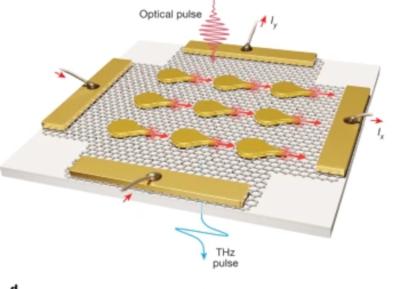Traditional microelectronic architectures are currently used to power everything from advanced computers to everyday devices. However, scientists are always on the lookout for better technologies. Recently, Los Alamos National Laboratory scientists and their collaborators from Menlo Systems and Sandia National Laboratories, have designed and fabricated asymmetric, nano-sized gold structures on an atomically thin layer of graphene. The gold structures are dubbed “nanoantennas” based on the way they capture and focus light waves, forming optical “hot spots” that excite the electrons within the graphene. Only the graphene electrons very near the hot spots are excited, with the rest of the graphene remaining much less excited.
Illustration of an optoelectronic metasurface consisting of symmetry-broken gold nanoantennas on graphene. Image from Nature
The team adopted a teardrop shape of gold nanoantennas, where the breaking of inversion symmetry defines a directionality along the structure. The hot spots are located only at the sharp tips of the nanoantennas, leading to a pathway on which the excited hot electrons flow with net directionality — a charge current, controllable and tunable at the nanometer scale by exciting different combinations of hot spots.
“Most modern technologies, from computers to applications like energy harvesting, are built on the ability to push electrons around,” said Jacob Pettine, Los Alamos physicist at the Center for Integrated Nanotechnologies (CINT). “But the way we control this charge flow remains very limited by conventional materials and structures.”
“These metasurfaces provide an easy way to control the amplitude, location and direction of hot spots and nanoscale charge current with a response speed faster than a picosecond,” said Hou-Tong Chen, a scientist at CINT supervising the research. “You can then think about more detailed functionalities.”
The conceptual demonstration in these optoelectronic metasurfaces have a number of promising applications. The generated charge current can be naturally utilized as the signal for photodetection, particularly important at long wavelength infrared region. The system can serve as a source of terahertz radiation, useful in a range of applications from ultra-high-speed wireless communications to spectroscopy characterization of materials. The system could also offer new opportunities for controlling nanomagnetism, in which the specialized currents may be designed for adaptable, nano-scale magnetic fields.
The new capability may also prove important for ultrafast information processing, including computation and microelectronics. The ability to use the laser pulses and metasurfaces for adaptive circuits could allow for the dispatching of slower and less versatile transistor-based computer and electronics architectures. Unlike conventional circuits, adaptive structured light fields could offer completely new design possibilities.
“These results lay the groundwork for versatile patterning and optical control over nanoscale currents,” said Pettine. “Along with the valuable applications in the laboratory, vectorial metasurfaces may enable advances in many different technological realms.”
